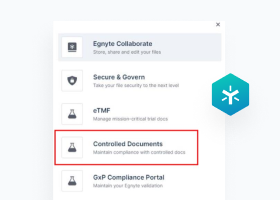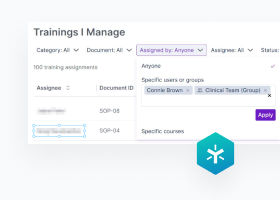Egnyte for Financial Services
Let’s jump in and learn:
- What Is Modern Records Management?
- The Key Components of a Modern Records Program
- What Are the Three Biggest Challenges in Records Management?
- What Are the Different Types of Records Management?
- What Are the Five Essential Elements of an Effective Records Management System?
- Modern Records Management Is a Must for All Organizations
What Is Modern Records Management?
Modern records management takes a digital-first approach to traditional records management, which is primarily paper-based and manually managed. Modern records management takes advantage of software and processes designed to optimize productivity and accessibility, helping organizations better manage the exploding volumes of records and the growing number of rules that govern them. Other benefits of modern records management programs are ensuring compliance, reducing risks, and lowering costs.

| Modern Records Management Definition from ARMA (Association of Records Managers and Administrators) International “The field of management responsible for establishing and implementing policies, systems, and procedures to capture, create, access, distribute, use, store, secure, retrieve, and ensure disposition of an organization’s records and information.” |
Modern records management programs handle a wide range of information (e.g., emails, files, social media, database transactions, paper). Modern records management systems help organizations identify, classify, manage, access, and dispose of information. Among the types of information that modern records management systems help manage are:
- Information that is subject to legal and regulatory recordkeeping requirements that dictate retention and accessibility times
- Information with critical business value that is required to run a business
- Information that needs to be accessible to groups in specific departments and team members across an organization for sharing and collaboration
- Highly sensitive information (e.g., confidential corporate data, personal Identifiable Information or PII, protected health information or PHI) that is subject to various and ever-changing data privacy laws
- Information that is transitory that should not be saved
The Key Components of a Modern Records Program
When developing a modern records management program, it is essential to take time to consider why the organization needs it. Once this is determined and the scope of the modern records management program is defined, it is helpful to understand the components. The following are the two key components of a modern records management program.
Records retention policy
The retention policy is foundational to a modern records management program. It defines the “what,” including objectives, scope, definitions, and guidelines. It also includes specific roles and responsibilities for staff dedicated to records management and legal teams.
Records retention schedule
A records retention schedule defines record categories, the records within that category, and the minimum retention period.
Data placement directives
Data placement directives combine records retention policies and schedules with technology to create a modern records management program.
Training
Once a modern records management program has been set up, training anyone who generates records on how the policies work, why they are in place, and how to use the systems is critical.
What Are the Three Biggest Challenges in Records Management?
Like any complex undertaking, a modern records management program has challenges. Though daunting, the right tools and processes can overcome these challenges. The primary challenges with a modern records management program are:
- Exponentially growing numbers of records in disparate formats
- Increasing and changing compliance requirements
- Difficulty enforcing records management processes
- Too many records are kept active when they should be destroyed or archived
- Inconsistent indexing, making access time-consuming and difficult
- Lack of control over records
- Poor to no efficient audit capabilities
What Are the Different Types of Records Management?
There are two main categories of records management systems electronic and paper-based. A modern records management program blends the two by digitizing paper records. Within these categories, there are four types of records:
1. Official records, which include critical operational and legal records that require retention
- Policy records (e.g., plans, rules)
- Organizational documents (e.g., budgets, org charts)
- Governing documents (e.g., manuals, directives)
- Reporting documents (e.g., annual reports, meeting minutes)
- Operational records (e.g., procedural records, administrative policies)
- Legal records (e.g., contracts, licenses, hearing transcripts)
2. Transitory records, which have temporary value and do not require retention
3. Non-records, which do not have any long-term use, such as drafts or duplicates
4. Personal records, which are not related to the operations of an organization
What Are the Five Essential Elements of an Effective Records Management System?
Modern records management is a complex undertaking, but is less daunting when broken into its core elements. The five essential elements of an effective modern records management program are as follows.
Step 1 of a modern records management program: Inventory and Classify Records
An effective modern records management program starts with a complete inventory of records, documentation of where they originated, and their classification. And, as new records are created, this information should be captured and recorded. Although modern records management is primarily focused on digital records, this exercise must incorporate physical records.
Step 2 of a modern records management program: Create Policies and Procedures
Policies and procedures are vital to any modern records management program as they ensure that operational and legal requirements are met. Effective modern records management policies and procedures strike the right balance between governance and administrative quicksand. Modern records management policies and procedures should encompass all records and media types, including email and social media. It is also imperative that modern records management policies are communicated clearly and applied consistently throughout the organization.
Modern records management policies also need to address requirements for records retention and eliminate the “save all” approach taken by too many organizations. Records should only be saved for as long as they are required. Some records have proscribed retention rates set by compliance requirements. Others should be saved for as long as they have value to the organization. But a significant portion of records should be destroyed regularly in a systematic manner. It is important to consider the following when developing retention periods as part of modern records management.
- Create a standardized record classification system.
- Understand all federal, state, and local requirements.
- Document how long records must be retained along with the appropriate disposition.
- Categorize records based on needs:
- Administrative
- Evidential
- Fiscal
- Historical
- Informational
- Legal
- Vital record
Step 3 of a modern records management program: Develop Strategies for Accessibility and Storage
An important factor in a successful modern records management program is the ability for users to access information when needed. A few considerations related to access and storage for a modern records management program are as follows.
- Creating a consistent and intuitive system for indexing records for fast and easy retrieval
- Developing processes for transferring records to archival storage
- Establishing and enforcing access procedures for sensitive records
- Implementing storage solutions for active and inactive records
- Providing directives on how and where to store records related to litigation
Step 4 of a modern records management program: Ensure Audit Readiness
A core function of modern records management is facilitating audits. Whether it is an internal audit or one conducted by a governing body, a well-run modern records management program can streamline the process and minimize any impacts on productivity. To ensure audit readiness, a modern records management program should include regular reviews of:
- Employees’ ability to access relevant records
- Indexing accuracy and accessibility of documents
- Processes for destroying records
- Retention schedules to be sure that they align with the latest laws and regulations
- Systems in place to protect and preserve records
Step 5 of a modern records management program: Disposition of Records
Another important function of a modern records management program is disposition. This is the final Step four of a modern records management action taken when a record becomes inactive. Disposition can be the destruction of a record or the archiving of a record for permanent preservation. Whichever disposition is selected, it should be documented so the record can be accounted for in the future. This final step is important, because it helps organizations avoid compliance violations or continue to increase their attack surfaces.
Modern Records Management Is a Must for All Organizations
Any organization that creates records that require retention for business or compliance purposes must implement a modern records management program. Even small organizations create more content than can be effectively and efficiently managed without a modern records management system.
Egnyte has experts ready to answer your questions. For more than a decade, Egnyte has helped more than 16,000 customers with millions of customers worldwide.
Last Updated: 9th October, 2023


